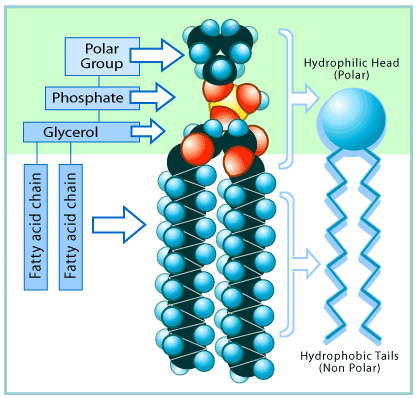A. Daily Blog
9/29/10-
Today we began discussing membranes. We focused mainly on the plasma membrane of cells, which is a phospholipid bilayer. Although this may seem obvious, the chief function of the plasma membrane is to keep the important cell stuffs inside and the stuff the cell doesn't want outside of the cell, out side of the cell. The cell membrane is dynamic and changes in response to environmental changes in order to maintain its ideal fluidity. The plasma membrane is built up through exocytosis, as phospholipids are transported from to the smooth ER then to the Golgi and *boom* the vesicle is combined into the plasma membrane via exocytosis. It is broken down through the process of endocytosis. In addition, we reviewed transmembrane proteins which fall under the category of co-translational proteins.
10/1/10-
Todays lecture focused on Membrane structure, concentration gradients, and the laws of thermodynamics. Lecture began with an introduction to the laws of thermodynamics, and the first two laws are: 1. Energy cannot be created or destroyed; it is just transformed from one from to another. 2. Disorder in the universe is constantly increasing (Entropy). This was then parlayed into a discussion about concentration gradients, which create more order in the cell. Concentration gradients are also very unstable, and have a high amount of potential energy, akin to a rubber band stretched backwards ready to fire. We also discussed the different types of transporters, and those are Uniporter (Single molecule or ion), Symporter (2 or more ions transported in the same direction), and Antiporter (2 or molecules transported in opposite directions).
10/6/10- Today we just reviewed for the test on Friday.
B. Useful Materials
 |
This image shows a basic description of facilitated diffusion, and illustrates the difference between carrier proteins and channel proteins. |
 |
This image shows the phospholipid, and comprehension of this is vital for understanding of the role of the phospholipid bilayer. |
|
During one of the lectures we discussed the Nobel-prize winning experiment that discovered Aquaporin, and the vital role it plays in the diffusion of water. This artticle discusses the how aquaporins influence the disease hydrocephalus, as well as its role in Cerebrospinal fluid. It summarizes the current knowledge about Aquaporin 1 and 4, and how they relate to hydrocephalus and brain water physiology. |
Comments (0)
You don't have permission to comment on this page.